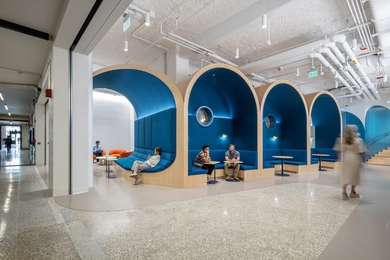MIT is one of 37 universities to join with government and private research organizations to develop a new and improved network for education and research.
The need for this new network, dubbed Internet II, became apparent to the research and education community this year, as broader use of Internet communication, particularly via the World Wide Web, has caused research data bottlenecks. Although the nation as a whole may not be aware of it, "national high-speed connectivity is a growing problem," said James D. Bruce, vice president for information systems and professor of electrical engineering. "More people are connecting and using the available bandwidth. New applications require additional bandwidth. We have adequate connectivity now, but clearly will require more in the near future."
Traffic on the MITnet backbone, such as e-mail, Web research and data transfer, has grown at an average of 64 percent annually since 1991 to 250 gigabytes per day. Nationally, the number of computers linked to the Internet has grown from 1.8 million in July 1993 to 12.9 million in July 1996, according to Network Wizards (see the Web page at
Internet II's goals are to develop and sustain up-to-date network capability for the national research community, enable use of new applications that fully exploit the capabilities of broadband networks, and integrate the project's work with ongoing efforts to improve academic Internet services.
This "next-generation Internet" will offer high capacity and low data loss, as well as enhanced network services that will enable multimedia applications and multicast delivery to dispersed groups, among other things.
In the preliminary draft of Internet II's architecture, the system will be centered around basic points of interconnection called GigaPOPs. Wide-area communications service providers will provide links between the institutional members, service providers and the existing commercial Internet at the GigaPOPs.
The participating schools have made initial commitments of $25,000 each to the project and are discussing further commitments. The National Science Foundation, the Defense Advanced Research Projects Agency, the Department of Energy, NASA and the National Institutes of Health will all be involved in the initiative. Corporate involvement will include IBM, Cisco Systems, AT&T, MCI and Sun Microsystems, among others.
In a separate announcement on October 10, President Clinton announced his support for a similar but broader Internet initiative. He has pledged $100 million for research to develop this new network. "America must have an Internet that keeps pace with our future," he said.
The initiative proposed by President Clinton has three goals:
��������������������������� To connect universities and national labs with high-speed networks that are 100 to 1,000 times faster than the existing Internet
��������������������������� To promote experimentation with new networking technologies
��������������������������� To demonstrate new applications that meet important national goals and missions in scientific research, national security, distance education, environmental monitoring and health care.
The proposed improvements "will make the Internet a more important and remarkable part of our own lives," President Clinton said. "They will enable our Defense Department to send intelligence instantly to our troops on the ground anywhere in the world. They will let doctors in rural areas scan their patients for cancer by tapping into supercomputers at university hospitals a long way away. They will allow Americans to take any class anytime, anywhere, in any subject."
A version of this article appeared in MIT Tech Talk on October 23, 1996.





